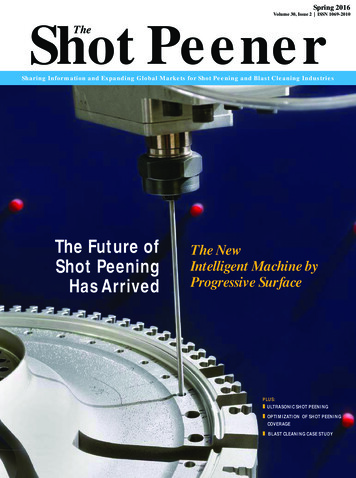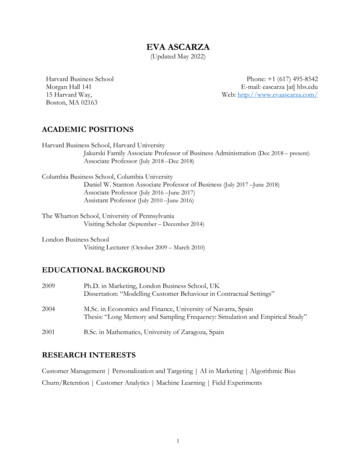
Transcription
Spring 2016Volume 30, Issue 2 ISSN 1069-2010Shot PeenerTheSharing Information and Expanding Global Markets for Shot Peening and Blast Cleaning IndustriesThe Future ofShot PeeningHas ArrivedThe NewIntelligent Machine byProgressive SurfacePlus: ultrasonic shot Peening oPtimization of shot Peeningcoverage blast cleaning case study
2The Shot Peener Spring 2016
Spring 2016 CONTENT16Visions of the FutureKumar Balan, a regular contributor to The Shot Peenermagazine, shares the insights of industry leaders in Part Twoof his series on the future of shot peening.20Blast Cleaning News from WheelabratorWheelabrator presents information on a new product and aequipment modernization success story for a manufacturerof valves for water, sewage systems, gas and industrialextinguishing systems in Poland.26Optimization of Shot Peening6Progressive Surface has chosen our spring magazine tointroduce their Intelligent Machine. This shot peeningsystem with many innovative features will help meet themanufacturing challenges for a rapidly growing segment ofthe aerospace industry.CoverageCoverage is a quantity and therefore thereare ways to quantify it. Several equations areincluded in this article by Dr. David Kirk. Youdon’t have to be a mathematician to use hisequations—programs such as Excel do all thework.38Cornell Forge Company Chooses Drum BlastEquipment from Blast Cleaning TechnologiesBlast Cleaning Technologies documents the installation of newdrum blast equipment for a well-established forging companyin Chicago, Illinois.44ITAMCO Connects12SONATS supports automotive, aerospace, energy andmedical industries with robust Ultrasonic Shot Peeningsolutions, from portable systems to robotic production lines.Forklifts to the IndustrialInternet of ThingsForklifts, the workhorses of theplant floor, are more valuablethan ever at ITAMCO. Thecompany has connected theirforklifts to the Industrial Internetof Things (IIoT)—the integration of machinery and equipmentwith networked sensors and software.THE SHOT PEENErSharing Information and Expanding Global Markets for Shot Peening and Blast Cleaning IndustriesSpring 2016 The Shot Peener3
OPENING SHOTJack Champaigne Editor The Shot PeenerThis and ThatTHE SHOT PEENErIn This MagazineI am so fortunate to be in the shot peening industry.I joined SAE in 1983 and became involved with theSurface Enhancement Division of Fatigue Designand Evaluation Committee. This committee assumedthe work of The Iron and Steel Committee whichpreviously maintained the documents relating to ShotPeening. I inherited many papers from this committeeand it was always interesting to see what was importantmany years ago. I found several references to shotpeening coverage (dating back to the early 1960s).You would think by now we had this topic pretty wellcovered (poor pun). Read Dr. Kirk’s article on coverage JACk CHAMPAIGNEand see what we’ve been missing. It’s dramatic.Ken I’Anson makes a reference to John Almen in his article. Coincidentally, Irecently received a phone call from a woman who said she is John Almen’s niece. Weplan to follow up with her and will share any interesting information she can provideon her uncle.Notable EventsThe tenth annual Japan shot peening workshop in February was a big success. It washosted by EI Shot Peening Training and Dr. Katsuji Tosha of Meiji University andsponsored by Toyo Seiko and Sintokogio. A record number of students from severalcompanies attended the classes and participated in achievement examinations.Special attention was paid to Nadcap and audits due to the large number of aerospacecompanies in attendance. Hands-on flapper peening training was led by BrigitteLaBelle from Shockform.The first call for papers for the 13th International Conference on Shot Peening(ICSP-13) has been published. Dr. Martin Lévesque is Chairman and Host. ICSP-13will be held September 18 - 21, 2017 in Montreal, Canada.This conference occurs every three years and gathers both scientific andindustrial communities working with the shot peening process. The conference willfeature technical talks from both academia and industry, as well as an exhibition ofthe latest peening-related equipment. The deadline for the abstract submission isDecember 31, 2016. More information can be found at www.polymtl.ca/icsp13/en/index.php.On a final note, I’m the Chairman of the International Scientific Committee forShot Peening—the group that sponsors the conferences—and if you’re interested injoining the committee, please email me at jack.champaigne@electronics-inc.com. l4The Shot Peener Spring 2016EditorJack ChampaigneAssociate EditorKathy LevyPublisherElectronics Inc.For a free subscription of theThe Shot Peener, go towww.theshotpeenermagazine.comThe Shot Peener56790 Magnetic DriveMishawaka, Indiana, 46545 USATelephone: 1-574-256-5001www.theshotpeenermagazine.comThe editors and publisher of TheShot Peener disclaim all warranties,express or implied, with respect toadvertising and editorial content,and with respect to all errors oromissions made in connection withadvertising or editorial submitted forpublication.Inclusion of editorial in The ShotPeener does not indicate that TheShot Peener management endorses,recommends or approves of theuse of any particular commercialproduct or process or concurs withthe views expressed in articlescontributed by our readers.Articles in The Shot Peener may notbe distributed, reprinted in otherpublications, or used on the internetwithout the written permission ofThe Shot Peener. All uses must creditThe Shot Peener.
Global engineering –Trusted solutionsClemco International Group –new look - same missionget in touchClemco was founded in the USA in 1949 with the joint goals of providing revolutionary high-production abrasive blasting technology, and of setting a new standardfor product quality, maximum efficiency, and operator safety and comfort. Thiscommitment to our customers remains unchanged year after year.www.clemco-international.comEngineeredby ClemcoSpring 2016 The Shot Peener5
INNOVATIONS IN SHOT PEENINGKen I’Anson Sales Engineer and Level III Certified Shot Peener Progressive SurfaceThe Future of Shot PeeningHas Arrived!THE SPrING EDITION of The Shot Peener is awonderful place to showcase new beginnings. Following along, cold and dark winter season, everyone looks forward tothe spring when dormancy is replaced with renewed growthand optimism.After five years of Research and Development atProgressive Surface and collaborative brainstorming withseveral key clients, we have chosen the spring of 2016 tointroduce The Future of Shot Peening to the general peeningpopulation. This new age of shot peening is the solution to aquickly growing problem in the aerospace industry.systems. “Fully Automated” means robotic part loading andclosed-loop parameter control and monitoring, but the gamechanger for shot peening automation is the “tool changer.”Our new shot peening system can robotically changefrom a conventional nozzle to a rotary lance head. It alsohas the ability to change between different sizes (length,diameter) of conventional nozzles and process/part specificlance nozzles. The Progressive Surface Tool Changer uses aThe ProblemComponents for the newest generation of commercial aircraftengines—the LEAP and geared turbofan (GTF)—have verycomplex geometries, narrow tolerances and demandingsurface treatment requirements. These components needa wide variety of shot peening tools and frequent peeningnozzle and lance changes to access all of their surfaces.Compounding the manufacturing challenge is thepopularity of these quiet, fuel-efficient, and low-maintenanceengines. The demand for the new engines will soon outpacemanufacturing unless automation is adopted. The combinedproduction rate of the 737 MAX and A320neo will reach 110aircraft per month in 2018 and each aircraft will require twoengines. The sales figures for these two aircraft models arenow at nearly 8,000 confirmed orders. The LEAP and GTFare being placed on other popular aircraft models as well.Industry analysts are saying there is no end in sight for thedemand of these two new engines.The SolutionThe answer to this opportunity is industrially hardened andprocess specific automation for the shot peening environment.The shot peening industry will never be known as an“early adopter” of automation. This is not due to a lack ofinterest or desire, but rather an environmental issue. Shotpeening has always been associated with very abrasive media,process dust and impact energy, making this industry a poorcandidate for automation that is, until now.In response to industry demands, Progressive Surfacehas manufactured several fully automated shot peening6The Shot Peener Spring 2016The Progressive Surface Automated Tool Changerwith Nozzle Magazine
ControlEmpire Abrasive Equipment continues to lead industry withbest in class peening and grit-blast solutions. Our highlycontrolled air-blast and recovery technology enables quickerproduction times. Our multi-discipline team of experiencedengineers, along with state-of-the art manufacturing andtesting facilities, deliver solution driven designs for a diverserange of industries; from aerospace and automotive to energyand medical.For over 70 years, we’ve been perfecting air-blast technology.Today, Empire has the most extensive range of advancedsolution-driven equipment to exact any of your air-blast needs.Let Empire engineer your competitive edge.Empire Abrasive Equipment215-752-8800 2101 W. Cabot Blvd.Airblast@Empire-Airblast.com Langhorne, PA 19047www.Empire-Airblast.comSpring 2016 The Shot Peener7
INNOVATIONS IN SHOT PEENINGcommon blast hose delivery system with a highly specializednozzle/lance holder. This Tool Changer resembles andoperates as seamlessly as the Tool Changers used globally inmulti-axis machining centers.Imagine shot peening a turbine disc or maybe a complexblisk. Conventional peening nozzles have always beenadequate for easy line-of-sight surfaces, but the disc has bladeslots and a variety of small bores that require a Rotating Lancenozzle. Additionally, the part has hidden areas in the mainbore that need a non-rotating L-Shaped lance, requiring anozzle change. Or maybe it’s the complex blades of a blisk thatneed to be peened without distortion, requiring a two-nozzleblisk tool.If this describes your shot peening operation, then you’reno doubt familiar with stopping the process and entering thepeening cabinet to change nozzles. Maybe you need to checkthe alignment of the new nozzle and, most likely, run anAlmen strip test. All of the above steps create non-productive,non-revenue producing machine downtime. These actionsalso invite operator error to enter the equation.The Progressive Surface automated tool changer isthe game changer our industry has been seeking. The shotContinuedpeening process and related industry is nearly 100 years old.I can’t help but wonder what Mr. Almen would think of thetoday’s shot peening industry—from its humble beginningsof manually grit blasting automotive valve springs to thepeening of today’s complex aerospace components.Speaking of the past and future, is the new Tool Changerour industry’s equivalent to Marty McFly’s Hoverboard?(Reference: Back to the Future II)Two key Features of the Intelligent MachineCabinet-Mounted CameraThe Progressive Surface Automated Cell illustrated inthis article includes a cabinet-mounted camera interfaceddirectly to the two robot controllers. This is a valuable, errorproofing tool. The camera compares the part to be peened tothe associated image stored in its part program. If the partloaded does not match the stored image’s information, theprocess will not start and the attending operator is given analarm message. When the correct part is loaded, the cameracompares the part orientation and automatically adjusts therobot off-sets to match the exact part position. This featureeliminates nozzle/part collisions and lance nozzle breakage.Features of theProgressive SurfaceIntelligent Machine Two articulated industrial robots, eachwith a dedicated wall-mounted toolrack Two RLD (rotary lance drives), eachdedicated to a robot Two pressure pot media delivery units,dedicated to a robot, with closed-loopmedia and air pressure control withinfinite adjustments and settings Six changeable nozzles/lances with nolimit to the number of nozzles otherthan cabinet interior space Dual work stations: one for processingand one for loading ShotMeter velocity sensor that dropsfrom the ceiling to measure mediavelocity Robotic camera to check partnumber via unique features and partorientation/position8The Shot Peener Spring 2016The Progressive Surface Intelligent Machine
Our digital spraying unit materializes the stable andconstant rate spraying of both of steel/non-steel shot For the first time in the world, we achieved the stableand constant rate spray, including for shot peeningand thermal spray pretreatment of nonmagneticmedia such as ceramic shot, alumina, glass beads,etc., which were difficult to use for precise processingin the past. For the fine shot of smaller than 200μm, only we canprovide stable and constant volume spraying. Digitally controlled spray unit achieves stable intensityand surface roughness.5-2-24 Matsue Edogawa-ku Tokyo132-0025 mail:info@fujimfg.co.jp28/1 Serithai Road, Minbri, Bangkok 10510 ndex.htmlE-mail:info@fujiblastech-thai.comSpring 2016 The Shot Peener9
INNOVATIONS IN SHOT PEENINGContinuedwears. This Automation Plus feature provides very accuratemonitoring of the peening process to the point where manyusers are creating new shot peening specifications that greatlyextend the interval between Almen strip test runs.Note: For now and the foreseeable future, Almen stripswill still be used when setting up the initial peening programsand for machine verification.The Progressive Surface ShotMeterThe ShotMeterThe second Automation Plus feature is the ShotMeter.The ShotMeter is an optical sensor that accurately senses,measures and records the actual shot peening media velocity.For the system discussed in this article, the ShotMetersensing head is located in the ceiling of the peening cabinet,extending for easy robot access and retracting when not inuse. Once programmed, the robot will present the peeningnozzle to the sensing head and the media velocity will bemeasured and compared to the part program requirements.After the velocity comparison is complete, the peening cyclecan commence.The media velocity is almost like a fingerprint—the blasthose diameter and length create unique media velocity witheach different media flow and air pressure. Over time, thevelocity slowly changes as the hose wears. The same is truefor the blast nozzle. Virtually each and every nozzle type,length and internal diameter has a unique velocity with agiven media flow and air pressure parameter when the nozzleis new. The media velocity is altered as the nozzle slowlyThe Future of Shot Peening is NowIndustry practitioners and experts alike agree there is a needand desire to automate and error-proof the process. Manynaysayers have preached that the environment was too harshand dirty to house cameras and tool-changers. Until now, allof this was true.A new generation of Automated Shot Peening systemshave been designed and proven in the field. Maybe for yourapplication, automation starts with robotic or automatedpart loading. Maybe your requirements include in-processmedia changes to complete a part. Or, maybe your partgeometry and closing tolerances need more surface-specificpeening nozzles. In any of these examples, automation is theanswer and with the exciting new generation of shot peeningequipment, all is now possible. lThe Progressive Surface Intelligent Machineat MTU Aero Engines AGAbout Progressive SurfaceProgressive Surface is a global leader in the design andmanufacture of automated machinery and closed-loopprocess controls for shot peening, abrasive grit blasting,thermal spray coating, and ultra high-pressure waterjetstripping applications in the aerospace, energy, medical,military, and general manufacturing industries.The Progressive Surface Cabinet-Mounted Camera10The Shot Peener Spring 2016For more information, visit www.progressivesurface.com.
IPS.Innovative Peening SystemsFanuc CNC ControlledS SeriesRotary LanceFive Axis CNCComputer ControlledShot Peening MachinePart Capacity24” dia x 36” highL SeriesSix Axis CNCComputer ControlledShot Peening MachinePart Capacity48” dia x 48” highCNC is no longer exclusive to the Fortune 500Innovative Peening Systems2825 Simpson CircleNorcross, GA 30071770-246-9883Our affordable CNC machines allows every shot peener toeliminate manual nozzle setups. CNC offers exceptionalpart processing speeds, accuracy of peening and consistentquality of parts.Spring 2016 The Shot Peener11
PrOCESS rEVIEWJuliette Tricoire Sonats www.sonats-et.comUltrasonic Shot Peening:From Portable Systems to robotic Production LinesA robust process used by Automotive, Aerospace, Energy and Medical industriesTHE STrESSONIC Ultrasonic Shot Peening (USP)process is similar to conventional shot peening (CSP) in that itis a cold-working surface treatment. Both use media to impactthe surface of a mechanical part, generating a compressiveresidual stress layer and improving material mechanicalproperties. Both enhance fatigue life and resistance to stresscorrosion cracking.USP differs from conventional shot peening methodsby the way kinetic energy is provided to the shot. Instead ofusing a constant air flow, gravity or high-speed rotation ofa turbine, USP uses the acceleration of a vibrating surfacecalled a sonotrode. The frequency of vibration is within theultrasonic wave range (20 kHz), which explains the name ofthe technique.with USP at 7-9A/F19A compared to 118µin/3.0µm Ra in CSPwith same Almen intensity.)How It WorksA generator delivers a sinusoidal electric signal that excites apiezo-electric transducer to convert this electric energy intoa mechanical displacement. Since the vibration deliveredby the emitter is small, the vibration must be amplified by aseries of boosters in order to transmit enough kinetic energyto the sonotrode which is directly in contact with the peeningmedia.Between the sonotrode and the precise area to bepeened, a specific enclosure is designed. Thus, the media ishermetically contained in a controlled volume. Longitudinalvibrations of the sonotrode surface randomly disperse mediainto the treatment volume as molecules into a gas. Thisgas-like movement leads to a homogeneous treatment on allsurfaces of the part being treated. gas turbine fir tree peening with reduced dismantling andcomplete media containment throughout the peeningoperationSurface Roughness / Peening Intensity Ratio ConcernsIn critical applications where deep compressive stresses arerequired and surface roughness must be kept at a minimum,USP can be a viable alternative to conventional shot peeningtechniques.Due to the treatment hermeticity, media quantity isreduced to several grams and USP can thus be performedusing high-quality media—such as bearing-balls with highsphericity—that do not abrade component surface. Media witha larger diameter can be used to reach a high intensity, inducedeep compressive stresses and lower surface roughness. (Forexample: 11.8µin/0.3µm Ra obtained on a TA6V part peened12The Shot Peener Spring 2016Handheld Hermetic Peening for Downtime ReductionReducing downtime—and its related costs—is a major issuefor Aeroengine and Gas Turbine manufacturers and MROindustries when handling major repairs on assembled parts.Portable USP systems by SONATS are the solution forthese industries. On-site shot peening with USP eliminatesthe need to dismantle the component and eliminates the riskof media loss inside the component. Typical applications ofthis localized shot peening are: Fan disk blended areas, without engine extraction, leadingto a 80% reduction of repair cycle time in-situ peening of damaged helicopter blades that saved 220,000 per blade (See Avion Solution, Inc. article in TheShot Peener, Winter issue, page 36)StressVoyager portable USP equipment on a storage trolley
Spring 2016 The Shot Peener13
PrOCESS rEVIEWStresstonic USP dynamic treatment ofautomotive output shaftsAutomated Multi-Station Machines forLean ManufacturingAutomotive gear manufacturers have to maintain highproductivity while insuring an efficient and repeatable processto critical transmission parts. In this framework, major OEMsare utilizing USP automated machine integration in specificpart production lines, thereby ensuring lean manufacturingpreservation. Specifically in USP machines for gear peening,treatment is performed in dynamic mode to reach apre-determined takt time. For example, a 40s takt time with a4-station machine will produce 500,000 parts/year.USP machines have the following automated functions:robotized handling directly from the previous processoperation, media counting (in units or in grams), sonotrodesand media wear-out monitoring, operator warning whenlifetime is reached, automated media loading/unloadingfor each independent workstation, global supervisionand periodic quality report issuance. In lower productionrate applications, semi-automated solutions are solicitedwith manual handling of the part through easily accessiblewindows.Stressonic USP automated 4-station machinefor automotive output shafts14The Shot Peener Spring 2016Stresstonic USP tooling plate for automotive output shaftsOn multi-station production machines, the part toolingsystem includes a specific hermetic enclosure, part supportand positioning tailstock (see photograph above).The tooling systems are modular. They can be set upin any machine station, independently from part referencegroup.Process requirements for transmission parts are specificallydemanding. USP is preferred in critical applications, such ascarburized gears and 20MoCr4 steel shafts, when high surfacecompressive stresses need to be homogeneously inducedon the teeth flanks and teeth roots. USP is able to generate-1100MPa (145Ksi) surface compressive residual stresses whilemaintaining a low Ra value.Robotized CellsThe highest automated solution for USP process is thecomplete handling of the process by 6-axis robots. For thetreatment of aerospace blisks, for example, a recent USPimplementation included the global handling of the partand robotized enclosure positioning to perform treatmenton blades, disc central bore, and disc holes. The decision touse USP technology for the blisks was mainly motivated byits ability to generate very similar residual stress profiles onboth intrado and extrado sides of the blades, insuring theaerodynamics of the part without distortion. lAbout SONATSFounded in 1991, SONATS, Europe Technologies Group,is an innovative industrial company specializing in metalsurface treatments using a patented ultrasonic processtechnology called Stressonic . The company headquartersare located in Nantes, France. SONATS providesequipment, services and competencies throughout theworld through an international network.EMPOWERING TECHNOLOGIES INC., SONATSAmerican subsidiary, is located in Alabama and providesNorthern America with local process support andequipment after-sales services.
Robotic/CNCShot Peening EquipmentPortable/MobileSystemsComplete Turn KeyProcess includingProgramming, FixtureDesign, andDocumentationPatent PendingAlmen Fixture DesignEI Distributor forMagnaValves, AlmenGages and Stripswww.peentech.com261 Burnham Street, East Hartford, CT 06108860-289-4328Shot PeeningNDTMass Media FinishingAerospace, Military &Commercial ApprovalsFAA Repair StationsKJ1R272K (CT) &G89R878X (GA)On-site CapabilitiesSurface Enhancement (CT & GA)Nondestructive Testing (GA)www.peentech.com8 Eastern Park RoadEast Hartford, CT 06108860-289-43283117 Emery CircleAustell, GA 30168770-941-9573Established 1966Spring 2016 The Shot Peener15
AN INSIDEr’S PErSPECTIVEKumar Balan Engineer Empire Abrasive EquipmentVisions of the FuturePart two of a two-part series on the past, present and future of shot peening and blast cleaning from industry leaders,including Michael Brauss, Dominic Cimino, Jim Harrison, Scott Nangle, Alain Portebois, Jim Whalen and Ron WrightWELCOME TO PArT TWO of our discussion on“Visions of the Future” in the shot peening world. In Part One,we established the current status of our shot peening industrythrough interviews with Jim Whalen of Progressive Surface,Ron Wright and Alain Portebois of Wheelabrator, MichaelBrauss of Proto Manufacturing, Jim Harrison and DominicCimino of Curtiss-Wright/Metal Improvement Companyand Scott Nangle of Empire Abrasive Equipment Company.This eclectic group further enlightened me on their thoughtson where we are headed—let’s see what they had to say.The Next Generation of Peening EquipmentOur group of experts was unanimous in their opinion thatcomputer-controlled equipment—for better monitoring andcontrol of the peening process—was the most importantinnovation in the past 20 years. However, each member ofthis group had a slightly different picture of the future.“Progressive Surface has successfully experimented with‘intelligent’ machines that reduce set-up time in the field,” saidJim Whalen of Progressive Surface. To explain the concept ofintelligent machines, let’s use the auto industry as an example.In the last decade, the automotive industry has developedthe driver interface with safety features such as lane control,back-up cameras and collision avoidance systems. They haveconcentrated less on the traditional engine, drive train andsuspension. Similarly, Jim believes the shot peening machinesof the future will incorporate error-proofing, enhancedinternal communication and better process design, leadingto a clearer handle on the machine’s health. He summarized,“This in turn will result in a machine that will not just raisealarms when the process is off track, but will actually be a fewsteps ahead in working towards a fix.” Jim also raised a veryvalid concern: The challenge of finding personnel capable ofworking with these intelligent systems.16The Shot Peener Spring 2016Alain Portebois and Ron Wright of Wheelabrator seethe future a bit differently, though still leading to a similarconclusion. “Peening equipment design is heading in thedirection of a machine tool, much like a machining center.There is a growing similarity in accuracy, repeatability andcontrols intuition,” said Ron.Alain added, “Aerospace customers of Wheelabratorare favoring offline programing techniques to optimizemachine utilization.” Alain also said that part programs areprepared well ahead of time with 3D models of components.Wheelabrator R&D is working on techniques to improve theefficiency of existing media propulsion techniques in bothwheel- and air-type systems.Scott Nangle of Empire Abrasive Equipment Companyalso believes in connectivity. “We are already seeing oursophisticated customers connect their peening machineswith the rest of their production machinery and processes.This is not just for validation and transfer of peening results,but also to put their already available electronic footprint toproductive use,” said Scott. He feels the end goal is to makethe diagnostics more intuitive, leading to earlier predictabilityof maintenance. This is especially valuable for aerospace andmedical components.Jim Harrison of Curtiss-Wright/Metal ImprovementCompany explained his vision relating to component design.“The future is about building shot peening process recipes aspart of the component design. This will greatly reduce set-uptime, costs and add better value to the entire operation. Thedesign of aerospace components will follow tighter normswith the use of finite element analysis,” said Jim.Michael Brauss of Proto Manufacturing believes X-RayDiffraction (XRD) will eventually become part of the peeningspecification. “More companies are following their Almenstrip validations with our XRD services,” said Mike.
A Cut Above1666 Enterprise ParkwayTwinsburg, OH 44087The advantage of Premier Cut Wire ShotHighest Durability Due to its wrought internal structure withalmost no internal defects (cracks, porosity, shrinkage, etc.) thedurability of Premier Cut Wire Shot can be many times that ofother commonly used peening mediaAsCutImproved Consistency Highest consistency from particleto particle in size, shape, hardness and density compared tocommonly used metallic media.Highest Resistance to Fracture Premier Cut Wire Shotmedia tends to wear down and become smaller in size ratherthan fracturing into sharp-edged broken particles, which maycause surface damage to the part.NormalConditioningLower Dust Generation Highest durability equals lowestdust levels.Lower Surface Contamination Cut Wire Shot doesn’thave an Iron Oxide coating or leave Iron Oxide residue — partsare cleaner and brighter.Improved Part Life Parts exhibit higher and more consistentlife than those peened with equivalent size and hardness caststeel shot.SpecialConditioningSubstantial Cost Savings The increase in useful life ofPremier Cut Wire Shot results in savings in media consumptionand reclamation, dust removal and containment, surfacecontamination and equipment maintenance.Premier Shot Cut Wire Products forAutomotiveMedicalAerospace Applications Worldwide(330) 405-05831666 Enterprise Parkway,Twinsburg, Ohio 44087Spring 2016 The Shot Peenerpremiershot.com 17
AN INSIDEr’S PErSPECTIVEContinuedSpecifications and ConformanceDominic Cimino of Curtiss-Wright/Metal ImprovementCompany is well-informed on specifications. He said, “We don’tsee a relaxation in specifications. We see them getting tighteras companies spread their operations over multiple locations.”Jim Whalen said, “Specifications have been harmonizedt
Electronics Inc. For a free subscription of the The Shot Peener, go to www.theshotpeenermagazine.com The Shot Peener 56790 Magnetic Drive Mishawaka, Indiana, 46545 USA Telephone: 1-574-256-5001 www.theshotpeenermagazine.com The editors and publisher of The Shot Peener disclaim all warranties, express or implied, with respect to











